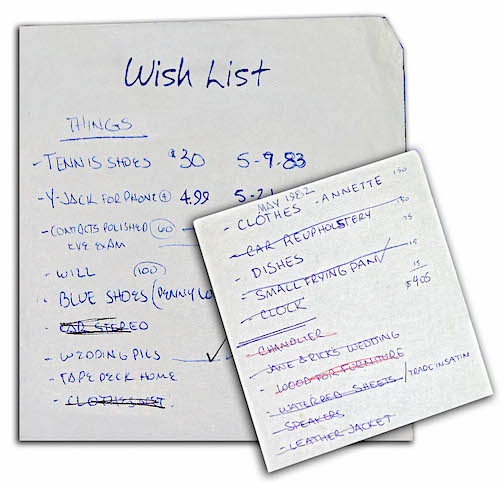Our Free Wish List for Kids is an awesome way to teach kids to save for purchases that they want to make. It works for kids or adults and helps minimize impulse buying. It also helps to set financial goals and rewards delayed gratification.
Get the .pdf and .doc file here by sharing your email address
(we won’t sell or give your email address to anyone else. And we’ll only send you a couple of emails each month)
This article describes how we first came up with the wish list for kids concept for our kids.
A Kids Wish List Changed Our Lives
We’ve always made lists: chore lists, errand lists, to-do lists, projects lists, possible baby-names lists, financial goals lists, Christmas lists — and the lists go on and on.
But years ago, when we were “dirt poor,” we started doing something that has stuck with us to help avoid impulsive and costly purchases. It has also helped us to stay focused on what we really want and has given our kids and us great satisfaction. It’s something we call a wish list.
Danger Lurks in the Toy Store
This happened years ago, when the kids were much younger, but we still remember the sheer terror that seized our hearts when we realized our terrible mistake. What were we thinking? We probably should have had our heads examined.
Were we insane?
The idea of taking three young kids into a toy store was utterly ridiculous.
Did we really expect that walking the kids down those aisles of colorfully packaged, highly advertised, marvelous little toys — all at a kid’s eye level — wouldn’t stimulate an enormous rush of uncontrollable desire in our children?
Well, it did.
And we had to think and think fast. The prospects of either having to deal with whining kids for the rest of the week or managing expenses that would exceed the gross national product of Liechtenstein (a small country in the Alps between Switzerland and Austria) were equally disturbing.
We looked at each other in panic and said, “Wouldn’t this be a great time to start a list?”
So as we walked the aisles and one of the kids expressed an interest in a particular toy, we simply said, “Oh, that’s a great idea, honey, let’s put it on your wish list.”
And that seemed to calm their “wanters,” at least for a few minutes.
T
Find out if your child become financially independent
Instead of Saying NO to Your Kids
This Wish List for Kids strategy worked for a few reasons:
- First, we didn’t say absolutely “No” to their desires.
- Secondly, they had hope. Mom and Dad were taking time to write it down.
The item was being considered. They knew from our past track record that we made lists and that items on a list were important.
And they knew that each year we assembled Christmas lists for each of the kids so that when relatives called and asked what they should buy for the holiday (or their birthdays), we had an answer.
The Power of A Written Wish List with Kids
As a result, most of the items on the list found their way under the tree each December. Lastly, the strategy worked for us because we didn’t have to cave into impulsive choices.
By putting the item on the list, we had time to talk with each child over the ensuing weeks about items on the list and determine if there was a deep-seated desire or just a passing fancy to have them.
It also gave us time to find the best price at a store or from an alternative source. We’re always amazed at how many items kids and adults express a strong desire for one minute, and days later, can’t even recall why they thought the item was so desirable.
Kids Growing Up
As our kids grew older they internalized the wish list idea. They started writing down things they wanted to by. They also wrote down things they wanted to do, like going to Disneyland.
The cool thing was when they wrote down their goals, they put their list in their spend money envelope. It’s part of our Payday System for kids.
How Adults Can Use A Wish List
When we bought our “dream house” we took list-making to a new level. We try to spend one weekend alone (without the kids) each year. One particular weekend, we took a loose-leaf notebook, some divider tabs and lots of blank paper with us to help us dream and plan projects for the house. We listed things we wanted to buy, like furniture, clocks, and lamps, as well as projects for the exterior and interior of the house.
We listed small and large projects. And finally, we listed things to be done in the short term (one year or less) and projects to be done in the long term (“Someday, when we have the money, wouldn’t it be great if?”) We made the lists and “guesstimated” what each project would cost. It was fun, scary (at least the total price was scary), overwhelming and really helpful. That set of lists was made more than 13 years ago — and we’ve added to it on an occasional basis.
What We Have Accomplished
We’re amazed by what we have accomplished in the ensuing years. Whenever we complete a project, we put the completion month and year next to it, along with a final cost. But more comforting are the items we’ve crossed off the list over time after reflecting and deciding, “No, we really don’t want to do that.”
Another advantage of the House Projects Book wish list is that once an item is written down, mentally it is more real. And because it is more real, we’re more watchful for sales or free materials and can start gathering its components over time, knowing that they will eventually be used.
An Old Wish List Looks Silly

Back in 1982, we started our first wish list on half a sheet of paper. Scrawled on that list were about 10 items that we thought we couldn’t live without. One was a clock we had seen at JC Penney. It had a wooden frame with a white face and modern numbers on it. When we first checked the price, we realized we couldn’t afford it. But it sure looked good and we sure wanted it, so we wrote it down.
A few months later, we were invited to a wedding of some dear friends. Annette sang during the ceremony and as a thank you gift, Rick and Jane gave us a present. We opened it and . . . OK, you’re not going to believe that this really happened, but inside the package was the exact style of clock that we had wanted! Amazing? Yes. Unexpected? Certainly. Appreciated? Without question. It is still an awesome memory . . . and the clock is still in use today.
Blue Shoes on the Wish List
OK, this is a little embarrassing, but on that same wish list from 1982, Steve had written down something that he wanted. It was a pair of blue leather shoes (no, not like the “Blue Suede Shoes” of Elvis fame). It seems ridiculous now, but that’s what he wrote down. Fortunately, the blue shoes remained on the list and never made it to the closet.
But the great thing about writing it down is that as the item stayed on the list, the impulse was momentarily satisfied, and after some time and some more rational thinking, the purchase was simply forgotten. Now, pay close attention to this closing section — It could save you thousands of dollars and years of heartache.
Wish Lists Can Help Marital Happiness
If wish lists aren’t written and referred to, danger lurks ahead. When one spouse has a hare-brained idea (like the blue shoes), the saner spouse (in an effort to save the family fortune) will feel compelled to point out the flaw in thinking (“What will you wear blue shoes with?”). This could inevitably lead to an argument (or “discussion” if that’s more your style). And then perhaps this could lead to hurt feelings.
Money arguments over stuff could even lead to days of not talking and possibly nights on the couch. If there’s constant money arguments, this could lead to needing to see a marriage counselor, which will most likely cost more than the price of the item in question. So you see, a wish list will not only save you a fortune, keep you dressed reasonably, and reduce stress, but it might even save your marriage.
Get the .pdf and .doc file here by sharing your email address
(we won’t sell or give your email address to anyone else. And we’ll only send you a couple of emails each month)

